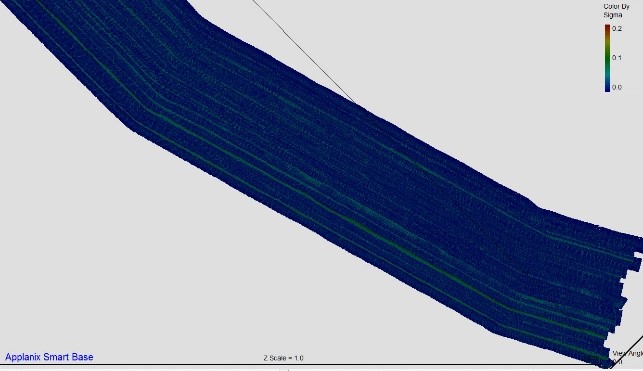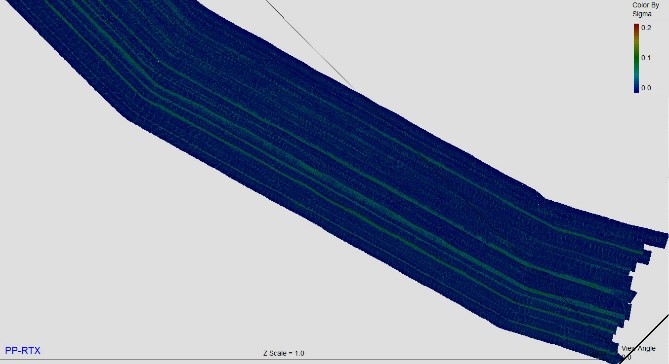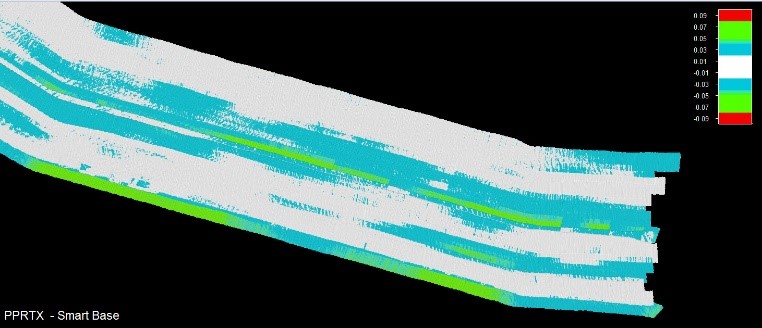Applanix PP-RTX™ in Hydrographic Survey
Introduction
Applanix’ industry leading POSPac MMS GNSS Inertial software, and in particular the Applanix SmartBase (ASB) post-processed virtual reference station technique, has been widely adopted as a robust and reliable method of Direct Georeferencing multibeam data. New in POSPac MMS 8.0 is a unique PP-RTX™ GNSS aided-inertial module that provides centimetre-level post-processed positioning accuracies without the use of local reference stations. This new method integrates Trimble CenterPoint® RTX technology into POSPac MMS. RTX is Trimble’s approach to PPP with advanced ambiguity resolution, providing its own ephemeris correction service, leading to integer-level ambiguities for accuracy approaching that of RTK. Applanix’ industry-leading POSPac MMS GNSS Inertial software, and in particular the Applanix SmartBase (ASB) post- processed virtual reference station technique, has been widely adopted as a robust and reliable method of Direct Georeferencing multibeam data.

A global network of approximately 100 stations tracking GPS, GLONASS, BDS, QZSS and Galileo provides the raw data for analysis and processing to produce the PP-RTX corrections, which are then made available via the internet within minutes of real-time.
Compared to real-time PPP services, the PP-RTX post- processed approach provides a number of advantages:
Almost no Convergence Time
By processing the data in both the forward and backward direction, the already converged solution from the forward pass may be used as a “seed” for the backward direction.
Robust Acquisition of Correction Data
As noted previously, the PP-RTX data is available within minutes of real-time. This ensures a fast turnaround of the solution, previously unavailable for post-processed PPP services. In the context of a comparison to real-time PPP services, archiving the data on the internet ensures more robust and reliable access to the correction data. In turn, this improves availability and accuracy.
Performance Results
Performance analysis of 14 different datasets from various locations around the world was done by comparing the PP-RTX solution to that from SmartBase. The results are presented below.
| PP-RTX - ASB | mean | std | rms | 68% | 95% |
|---|---|---|---|---|---|
| North | 0.000 | 0.019 | 0.019 | 0.012 | 0.033 |
| East | -0.003 | 0.021 | 0.021 | 0.016 | 0.035 |
| Down | 0.018 | 0.046 | 0.049 | 0.043 | 0.086 |
Port of London Case Study
More recently, a new data set was collected by the Port of London Hydrographic Service on their vessel Maplin. Maplin is equipped with a POS MV™ OceanMaster GNSS-aided inertial navigation system for georeferencing the R2Sonic™ 2024 multibeam sonar. Hypack™ was used for data acquisition, and Fledermaus™ has been used for the visualization of some results.
The data was collected in the Thames Estuary, where Ordnance Survey OSNet GNSS reference stations provide the data necessary to compute a SmartBase post-processed VRS network. The Applanix SmartBase (ASB) technology allows the computation of a centimetric-accurate position solution, with distances to the nearest reference station on the order of 20-60 km. A comparison was then done between the ASB solution and that from PP-RTX. The results are shown below.

The maximum difference in horizontal is approximately 0.04 m in horizontal, and about 0.07 m in vertical. Both the ASB and PP-RTX SBET solutions were applied to the bathymetry, and the results compared. An rms surface derived from each SBET is shown below.
 |
 |
Differencing the two surfaces confirms the level of agreement, with no differences greater than 10 cm, and the majority less than 5 cm..

Summary and Conclusions:
POSPac MMS using PP-RTX aided-inertial technology:
- has been shown to match the North, East and Down position computed using the ASB (Applanix SmartBase) network Carrier Phase DGNSS processing for 15 POS MV data sets to an accuracy of 0.019m, 0.021 m and 0.049 m RMS respectively, which is sufficient to meet the accuracy requirements for a majority of mapping applications,
- does not need local reference stations,
- provides a convergence-free solution by combining the forward and backward solutions,
- is available 1 hour after data collection,
- allows for the Direct Georeferencing of a sample MBES data series in agreement with the equivalent ASB solution to better than 0.10 m, with the majority agreeing to better than 0.05
- and is available to be used by all models of POS MV.
PP-RTX is available as a subscription to be enabled on any POSPac MMS licence currently under maintenance. Both 6 and 12 month subscriptions are available. Please contact Applanix or your local reseller for further details.
Acknowledgements:
Applanix would like to thank the Port of London Authority for their generous assistance in collecting the data used in this case study.